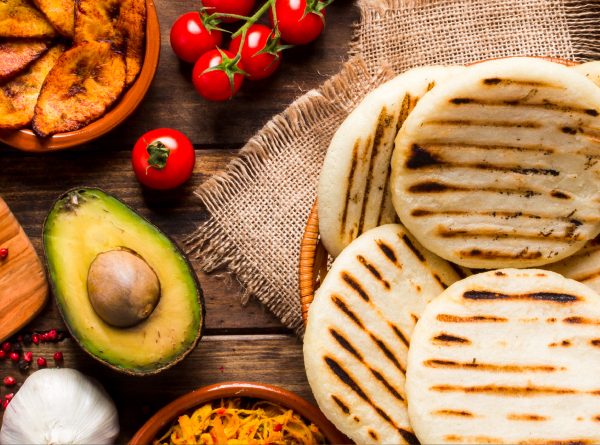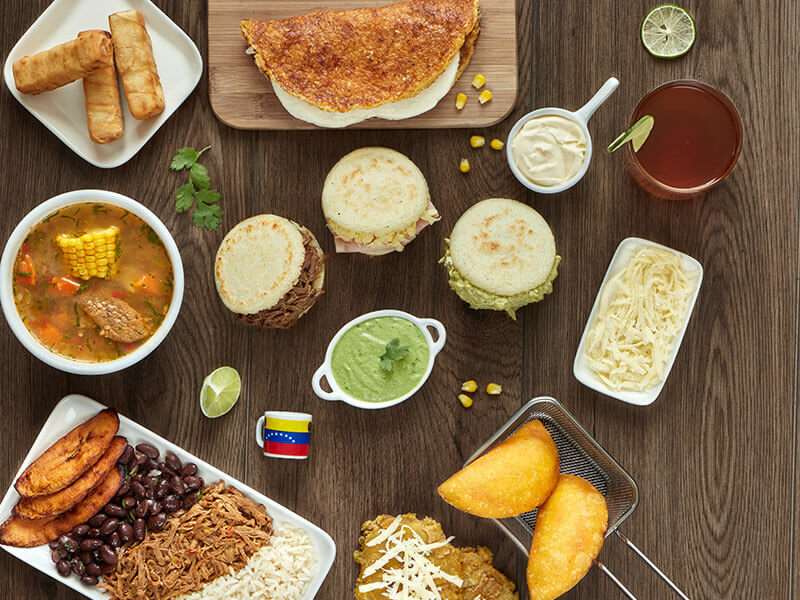
Venezuelan food is a fusion of Indigenous, African, and European influences, resulting in a unique and diverse culinary experience. The cuisine is characterized by its flavorful dishes and creative use of ingredients. Here we will explore the various aspects of Venezuelan cuisine.
Arepa

The dough for Venezuelan arepas consists of precooked cornmeal, salt, and water. One forms the dough into a thick, round patty and cooks it on a hot grill or skillet until the outside is crispy. The inside is soft and fluffy.
People can serve arepas as a side dish or as a main course and frequently fill them with cheese, meat, beans, avocado, or eggs. One can also serve them with butter, salsa, or other toppings.
“Reina pepiada,” a mixture of shredded chicken, avocado, mayonnaise, and lime juice, is a popular arepa filling. The “domino,” which consists of black beans and grated white cheese, is another popular filling.
In Venezuela, people can find Arepas almost anywhere. Street food stalls or small restaurants known as “areperas” frequently sell them. Arepas are versatile and delicious food that people can eat anytime, including breakfast, lunch, and dinner.
Venezuelan arepas, in general, are a simple and satisfying food that has become a beloved part of the country’s culinary culture.
Hallaca

In Venezuela, people typically eat Venezuelan Hallacas during the holidays because they are a popular and traditional holiday food. Hallacas are a type of tamale that consists of a flavorful filling wrapped in corn dough, which is then wrapped in plantain leaves and boiled or steamed until cooked through.
To make the filling for Hallacas, people usually cook a mixture of beef, pork, and chicken with onions, peppers, garlic, and spices. They then add olives, capers, raisins, and other ingredients to the mixture to make the filling sweet and savory.
To make the Hallacas dough, people combine cornmeal, broth, and annatto oil, which gives it a bright yellow color. Afterward, they spread the dough onto a plantain leaf, add the filling, and fold the plantain leaf over the filling to form a packet. Finally, they tie the packet together with a string.
Once assembled, the Hallacas are boiled or steamed until thoroughly cooked. The resulting dish is a flavorful and aromatic blend of tender meat and fragrant corn dough, with a hint of sweetness from the additional ingredients.
Hallacas are a holiday main course, served with pan de jamón and ensalada de gallina. Family and friends often share Hallacas due to their time-consuming preparation. Hallacas represents a unique blend of indigenous, African, and European influences in Venezuelan cuisine.
Pasticho

In Venezuelan cuisine, people typically make Pasticho, a popular baked pasta dish that has a flavor profile similar to lasagna. To make the dish, they layer long, flat pasta sheets with a filling of ground beef seasoned with spices such as garlic, cumin, and oregano. Then, they mix the meat with a rich tomato sauce that is thickened with a bit of flour or cornstarch and creamed with milk or cream.
To make the Pasticho, you should spread a layer of pasta on the bottom of a baking dish, followed by a layer of the beef and tomato sauce mixture on top. You should repeat this process until the dish is completely layered. Finally, sprinkle a generous amount of grated cheese, such as parmesan or mozzarella, on the final layer.
Once assembled, the Pasticho is baked in the oven until the cheese melts and the pasta is tender. The result is a warm and satisfying casserole ideal for feeding a crowd.
Pabellon Criollo
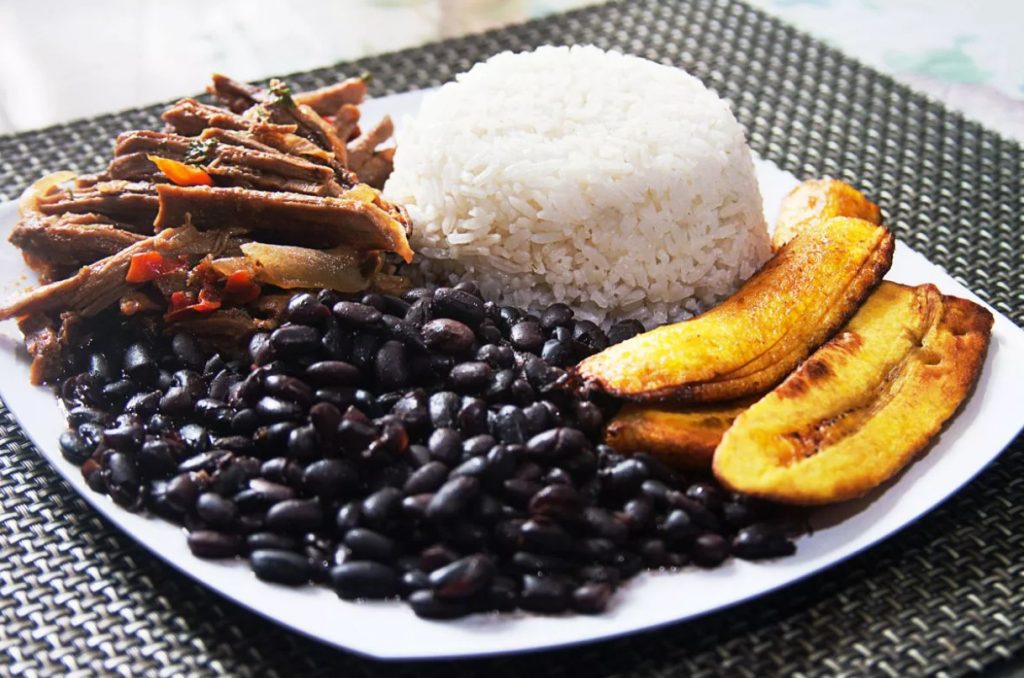
To prepare shredded beef, cook it with onions, garlic, and peppers and season it with cumin and other spices. For black beans, cook them with onions, garlic, and bacon and season with bay leaves and cumin. To cook white rice, add salt and optionally sautéed onions and garlic. To make fried plantains, slice them and fry them until the exterior is crispy and golden brown while the interior is soft and sweet.
Overall, this combination of dishes makes for a delicious and satisfying meal. The tender and flavorful shredded beef pairs perfectly with the savory black beans and fragrant white rice. The crispy and sweet plantains provide a nice contrast in texture and flavor.
Asado Negro
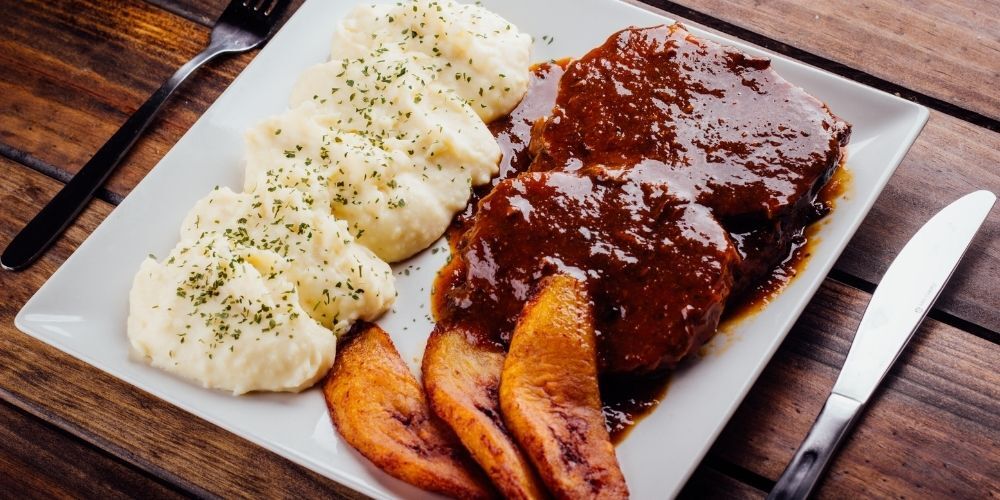
Venezuelan Asado Negro is a flavorful beef roast traditionally served on special occasions and holidays. The dish includes a marinated and slow-cooked beef roast that is flavorful and tender.
To make Asado Negro, marinate a beef roast in a mixture of red wine, garlic, onions, cumin, oregano, bay leaves, and other spices. Sear the beef in a hot skillet to create a crispy crust before transferring it to a slow cooker. Simmer the beef in the slow cooker for several hours, basting it with a mixture of marinade and beef broth to keep it moist and flavorful.
Once the beef is cooked, remove it from the slow cooker, strain the liquid, and reduce it to make a thick and flavorful sauce. Slice the beef and serve it with the sauce, often accompanied by rice or mashed potatoes and plantains.
Overall, Asado Negro is a delicious and hearty dish that is perfect for special occasions or when you want to impress guests with your cooking skills.
Pan De Jamon
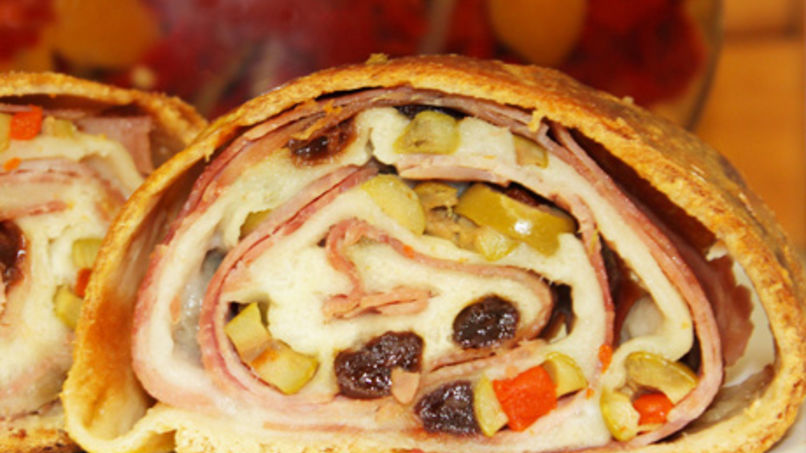
To make Pan de Jamón, prepare dough by combining wheat flour, yeast, sugar, salt, and water or milk. Roll out the dough into a large rectangle, then fill it with cooked ham, sliced olives, raisins, and other optional ingredients, such as bacon or nuts. Roll up the dough tightly and pinch the edges to seal the filling inside. Bake the bread until the exterior is golden brown and crispy, while the interior is soft and fluffy.
Alongside other traditional Venezuelan dishes such as Hallacas, which are tamales filled with beef, pork, and vegetables, people commonly serve Pan de Jamón as part of a Christmas Eve dinner or Christmas Day brunch. Additionally, people often accompany it with Dulce De Lechoza, a sweet dessert made from candied papaya.
Cachapa
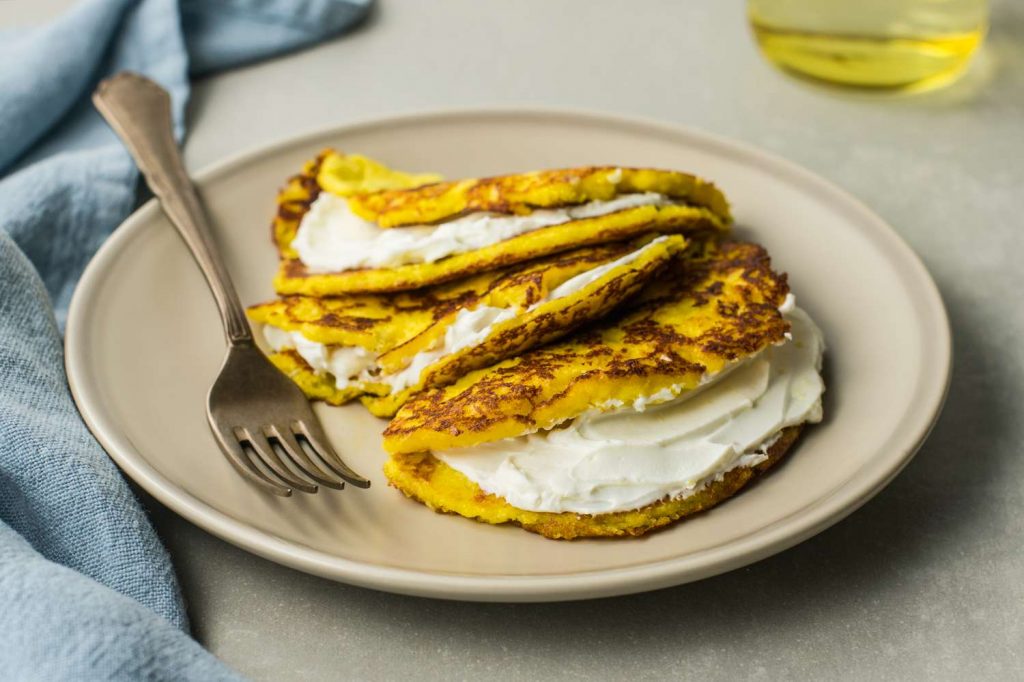
To make cachapa batter, blend fresh corn kernels with salt (and optionally, sugar) until a smooth batter is achieved. Ladle the batter onto a hot griddle or flat-top grill and cook until the exterior is golden brown and crispy while the interior remains soft and tender. Then, fill the cachapa with cheese, ham, shredded chicken, or beef, and top with butter and cream.
Cachapas are a popular street food in Venezuela and a popular dish in restaurants and homes. They’re trendy for breakfast or brunch but delicious any time of day. Cachapas are a delicious and comforting dish that highlights Venezuela’s culinary heritage and the importance of corn in Venezuelan cuisine.
Tequenos

Tequenos are a popular Venezuelan snack or appetizer that consists of cheese sticks wrapped in dough and fried until crispy. They are a tasty and flavorful treat that can be eaten alone or as part of a larger meal.
People typically make Tequeo dough from wheat flour, water, and salt, with other ingredients like cornmeal or egg. The most common cheese used is queso blanco, a soft, mild, and slightly salty variety. The cheese is cut into small sticks and wrapped in the dough before frying.
Tequenos are often served with guasacaca or salsa rosada dipping sauces. Guasacaca is made of avocado, cilantro, and other ingredients. Salsa rosada is made of ketchup, mayonnaise, and other ingredients. Tequenos are popular snacks at parties, family gatherings, and social events. They are enjoyed by people of all ages in Venezuela.
The tasty and varied cuisine of Venezuela offers a blend of Indigenous, African, and European influences, which results in delicious and mouthwatering meals. It has gained popularity among food fans all over the world because of its use of ingredients like plantains and yucca as well as its street food culture. A fascinating gastronomic experience, Venezuelan cuisine also reflects the nation’s rich history and cultural variety. Venezuelan cuisine is a must-try that will satisfy your taste buds whether you’re a foodie or just seeking something different.
Check out a new variety of cuisines here:

